Misyon Online - May-June 2008
They too Mourned for Him
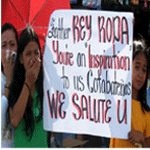 Fr Jesus Reynaldo A. Roda OMI, ‘Father Rey', expected it all along. But not the people of Tabawan, whom he had served for ten years before his brutal murder on 15 January at the hands of his abductors. One of Father Rey's Muslim scholars described the immediate reaction of the local people: ‘It was as if a big bomb was dropped in our midst and we got the shock of our lives. The whole island mourned. Some lost their appetite. Some kids don't want to go to school anymore'.
Fr Jesus Reynaldo A. Roda OMI, ‘Father Rey', expected it all along. But not the people of Tabawan, whom he had served for ten years before his brutal murder on 15 January at the hands of his abductors. One of Father Rey's Muslim scholars described the immediate reaction of the local people: ‘It was as if a big bomb was dropped in our midst and we got the shock of our lives. The whole island mourned. Some lost their appetite. Some kids don't want to go to school anymore'.
read more...
Adventure in the Philippines
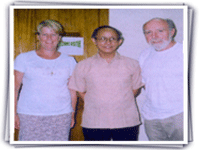 After a total of seventeen hours flying time from Dublin we arrived in Cagayan de Oro City, Mindanao, on 19 October 2006 where we were welcomed by the officers of the Senatus of the Southern Philippines. Our accommodation was in the Archbishop's house where we were graciously received by Archbishop Antonio Ledesma SJ. In the evening we joined the Senatus officers and the Spiritual Director Monsignor Rodolfo C. Roa for a meal.
After a total of seventeen hours flying time from Dublin we arrived in Cagayan de Oro City, Mindanao, on 19 October 2006 where we were welcomed by the officers of the Senatus of the Southern Philippines. Our accommodation was in the Archbishop's house where we were graciously received by Archbishop Antonio Ledesma SJ. In the evening we joined the Senatus officers and the Spiritual Director Monsignor Rodolfo C. Roa for a meal.
read more..
An Urgent Need: Engaging Other Faiths
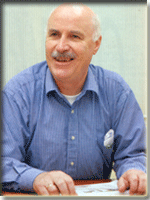 The Columban Superior General says understanding other religions helps us better understand God. This is an extract from an interview by Father Barry Maguire, now the editor of the Columban magazine in Korea.
The Columban Superior General says understanding other religions helps us better understand God. This is an extract from an interview by Father Barry Maguire, now the editor of the Columban magazine in Korea.
Fr Tommy Murphy, who became Columban Superior General in 2006, says Catholic missionaries such as the Columbans must engage with people of other faiths and religious traditions. He worked as a missionary in Korea beginning in 1974 and later continued his work in Taiwan.
read more..
Sitting at the Feet of a Beggar
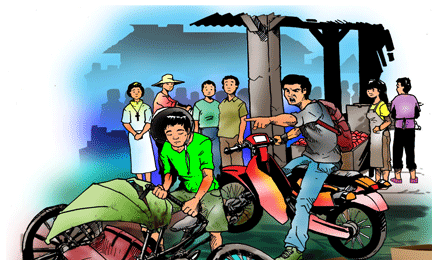 For more than a year now, I have been among a new people, learning to be one of them in order to become part of their life and their history. As I study the language, I have also learned to study the people I daily meet on the streets as a way of learning to live my religious life in dialogue with their life. I feel there is much I can learn specially from the poor and suffering, those easily pushed aside into the margins of society.
For more than a year now, I have been among a new people, learning to be one of them in order to become part of their life and their history. As I study the language, I have also learned to study the people I daily meet on the streets as a way of learning to live my religious life in dialogue with their life. I feel there is much I can learn specially from the poor and suffering, those easily pushed aside into the margins of society.
read more..
A Surprise Feast
Father Bunagan was ordained in 2005. Resources in the Diocese of Inongo Democratic Republic of Congo, where he is assigned, are very scarce.
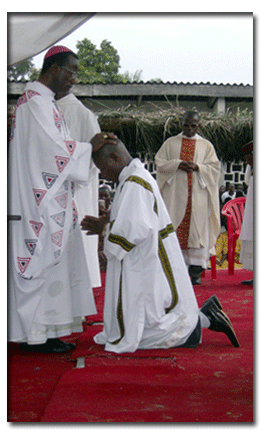
We often write articles regarding our missionary engagements. Many times these are stories about the sick, dying and poor people we’ve encountered. We need to share those stories in order to illustrate the serious needs we face. There are many sad stories in our mission countries, but there are also stories of hope. And sometimes we can be surprised by the real, influential people who are the ‘hidden’ actors in the mission. I want to tell you about a good, exciting and inspiring experience I had in the mission.
As a young, newly ordained and energetic missionary priest, I was assigned to one of our parishes in the Democratic Republic of Congo, namely Marie-Reine in Kutu, Lac Mai-Ndombe, in the Diocese of Inongo. It’s a parish located nearly 500 kms northeast of Kinshasa. It was our pioneering Belgian confreres who started this mission in the equatorial forest of Congo. The majority of the people here are members of the Bantu tribe, about 45,000 according to the most recent statistics. They speak local dialects called kisakata, kiwarya, kisengele and lontomba. The communal languages are Lingala and French.
The Surprise News
During the third week of February 2007 we received a surprise message from the provincial secretary informing us that one of our confreres, Deacon Francis Mfesao CICM, a missionary in Hong Kong at the time, would be ordained priest three weeks later in our parish! Upon hearing this unexpected news, some questions troubled me: How would we prepare? Who could possibly help us? Was it possible to be ready at such short notice?
One week later there was more surprising news, from the Diocese of Inongo: two diocesan deacons, Jacques Mbonenklime and Celestin Mbuyulu, would be ordained along with our confrere Francis. Knowing our limitations and the short timeframe to work with, my other Filipino confrere and I first called on the pastoral members to arrange a meeting.
At this initial meeting, the team members were also stunned at the news. They immediately anticipated the worries and difficulties. To ease their anxieties, we began with some brainstorming. The Congolese people love open discussion and ‘town hall’ type meetings. With our limited time, we needed concrete plans to come out of this meeting. We needed to decide how to prepare and organize before, during and after the ordination of the three new priests. We talked a lot about how to turn this ‘impossible feast’ into a possible one. The first proposal was to divide the work among committees. We agreed and formed seven in all. Since I love to eat and drink, and have a well-rounded stomach, they assigned me as a member of the food committee! I worked together with a Sister and an active lay woman, Ms Melanie Nzali.
The Reinforcements
The following day, we called on our parish council members to reinforce our teams. We asked them to brainstorm and give suggestions as well. They added some wonderful ideas which included involving the Basic Christian Communities. They also suggested asking for donations from Christians living in the 41 villages of the parish. We agreed! So, each of the leaders of the communities disseminated the news and responsibilities in their corresponding areas. Through this method, we were given the assurance that all our parishioners, even those living in the most remote peripheries, would ultimately have the chance to participate. And, indeed, this method was very effective.
Ordination Day
The bell rang at 5:00am sharp. Ordination day arrived before we knew it and everybody was in a hurry for the Mass. By 8:00am Bishop Philippe Nkiere Kena CICM of Inongo, the diocesan priests, some CICM confreres, choir members and acolytes were ready to start the procession. Because we had foreseen that our church would be too small to accommodate all the visitors, we proposed that the ordination be held outside. It was the only way to accommodate such a crowd and it worked very well. There were parishioners and visitors from far and wide!
The parishioners, even those from far-flung areas, really worked hard and made generous contributions during the preparation. We had committees for things such as decorations, the choir, liturgy, food, welcoming, and so on, and they all worked diligently to help make this a remarkable occasion.
The untiring efforts and dedication of one parishioner, Ms Mélanie Nzali, really struck me. Ms Nzali is a very enthusiastic member of our pastoral team. She runs a parish organization called BIBA TO (Bilenge Basi Tosalisana) that helps educate young women, with special attention to those not attending school. The young women are taught how to sew, cook and do household chores. Recently, Ms Nzali also started another program called ‘Lamuka’ (Wake up) to educate illiterate women. She easily solicited women from both programs to lend their support and their helping hands toward our event. The women spent days and nights preparing the food and washing the dishes. Ms Nzali worked many days and nights herself during the preparation and, in fact, spent a couple of sleepless nights on it as well.
Yet after all of the tiring preparations and sleepless nights, I noticed that the women still could tell good stories, crack jokes and share their sweet smiles. Truly, all of the volunteers from the various organizations provided the necessary ingredients for our success.
During the reception, the volunteers were particularly glad to hear the visitors’ appreciation of their food. One woman approached and told me how proud and grateful she was to hear the compliments. This made me realize that the hidden actors in the event really got to enjoy themselves too. To know that they were part of the success of such an important day in the lives of these new priests and in the life of their church made the generous workers the happiest people of the day.
New Insights
Although the people of God had nothing to contribute financially or materially, they gave in so many other ways. They shared in our efforts and they gave their time and talent. These are meaningful ways to express one’s contributions. It confirms the saying, ‘It is only when you share your whole self that you really give’. I’ve come to trust that there are always hidden actors who will surely help us in the mission. As long as we have the hands and hearts of the people, we’ll be able to work together and achieve surprising results! When Jesus showed God’s generosity in his multiplication of the loaves he convinced us his followers to bring out and share our ‘hidden food’. Amazingly the people present were able to afterwards gather still another twelve baskets full of bread.
Truly, just like Jesus with the Jews that day, the unknown missionaries of Kutu made this, our ordination feast, a surprise one!
Procession
This article first appeared in Missionhurst, the magazine of the CICMs in the USA, www.missionhurst.org , in October-November 2007 and is reprinted with permission.
You may write the author at: CICMs, PO Box 1323, 1000 MANILA or email him atvbunagan@yahoo.com
Adventure In The Philippines
The authors, officers of Conciliium Legionis Mariae, the central governing body of the Legion of Mary, made an official visit to the Philippines from 19 October till 12 November 2006. Liam Hayden and your editor were classmates in elementary school in Dublin,Ireland. The article first appeared in Maria Legionis, the quarterly of the Legion, in Issue No 4 2007.

Liam Hayden and Lucy McDonald with Archbishop Antonio Ledesma
After a total of seventeen hours flying By: Liam Hayden and Lucy McDonald
The authors, officers of Conciliium Legionis Mariae, the central governing body of the Legion of Mary, made an official visit to the Philippines from 19 October till 12 November 2006. Liam Hayden and your editor were classmates in elementary school in Dublin,Ireland. The article first appeared in Maria Legionis, the quarterly of the Legion, in Issue No 4 2007.
After a total of seventeen hours flying time from Dublin we arrived in Cagayan de Oro City, Mindanao, on 19 October 2006 where we were welcomed by the officers of the Senatus of the Southern Philippines. Our accommodation was in the Archbishop’s house where we were graciously received by Archbishop Antonio Ledesma SJ. In the evening we joined the Senatus officers and the Spiritual Director Monsignor Rodolfo C. Roa for a meal.
Next day we departed for Ozamiz City accompanied by the Senatus President Revie Echano, Vice President Rita Norma Saquin and former President Rose Manios. Regia officers led by President Cecilia Kaamiño, whose son Rodolfo is a Columban seminarian in Chicago, met us atthe ferry port and brought us to the Columban Sisters’ house. After lunch we drove to the Cathedral and met Archbishop Jesus Dosado CM. Then we visited the Carmelite Monastery where we met all 12 Sisters, nine of whom had been in the Legion. Our ‘moto perpetuo’ continued on the following day when we attended the 250th Anniversary of the shrine of the Birhen sa Cotta at the old Spanish fort in Ozamiz where a most beautiful Mass was concelebrated by two bishops and forty priests.
After the Regia meeting we made many new Legionary friends including the Regia Spiritual Director, Fr Arnold Daplin.
Next day we went to Alubijid where after Mass we were privileged to be sponsors to two tribal children who were being baptized by the Comitium Spiritual Director, Fr Jose Isagani E.Villamil. The Comitium meeting then took place chaired by Sr Marilou R Araneta, President, and a ‘Couples’ praesidium gave an illuminating report on contacts with troubled marriages and irregular unions.
On the following day, we left Cagayan De Oro at 4 am bound for Camiguin Island where we were met by Sr Alfreda E Diaz, Comitium President, and her officers. Afterwards we toured the island, stopping occasionally to admire the beautiful landscape. We visited a small rural church packed with legionaries young and not so young. After many conversations we returned to Mambajao where we attended a concert in which the extraordinary singing and dancing talents of priests, many of whom are Spiritual Directors of the Legion, entertained 2,500 people for several hours.
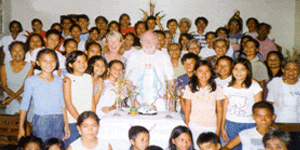
Some days later we attended a mass wedding of ten couples organized by the Legion at Balulang church, Cagayan de Oro. After lunch we visited the city’s open prison at Lumbia accompanied by a legionary police officer and another legionary. We were touched by the obvious need for friendship among the men and boys held there. Our day was completed by a visit to the Columban house were Frs Peter O’Neill and Paul Glynn welcomed us.
We attended the Senatus of Southern Philippines meeting, followed by a performance of traditional dancing and singing which we found most delightful. Our sojourn in Mindanao was coming to a close and for a finale we had the joy of attending the ordination of three young men to the priesthood by Archbishop Ledesma.
On 31 October we flew to Manila to commence the second part of our Philippines adventure. The Senatus officers greeted us and we attended a Comitium gathering in our honor and met Bishop Gabriel V.Reyes of the nearby Diocese of Antipolo.
On 3 November we were greeted in the packed Cathedral/Basilica of Malalos by hundreds of legionaries who waited for hours to meet us. We then moved on to Baliwag where we met Brigido Valmadrid, former Senatus President who after a visit to Brother Vic a sick legionary, brought us to Mass in the Cathedral. On Saturday 4 November we attended a Comitium meeting in Cabanatuan and met Bishop Sofronio S. Bancud SSS, an enthusiastic supporter of the Legion.
Next day found us at the Senatus meeting at Manila where we received a rapturous welcome. Our whistle stop tour continued on Monday when with Senatus officers we were received most graciously by Gaudencio Cardinal Rosales, Archbishop of Manila, at his residence in Manila. His Eminence is well informed on Legion matters and is most enthusiastic about its development in the Philippines. We took our leave of the Cardinal and went to the house of the then Apostolic Nuncio Archbishop Fernando Filoni where we were warmly welcomed.
Some Legion of Mary Terms
- The Latin terminology of the Legion of Mary is derived from that of the ancient Roman Legion.
- Praesidium: the basic unit of the Legion.
- Curia: a body governing several Praesidia in a city, town or district.
- Comitium: a Curia supervising one or more other Curiae.
- Regia: a council designated by the Concilium to exercise authority over the Legion of Mary in a large region.
Senatus: a council designated by the Concilium to exercise authority over the Legion of Mary in a country or in a large area of a country.
Next day we departed for Ozamiz City accompanied by the Senatus President Revie Echano, Vice President Rita Norma Saquin and former President Rose Manios. Regia officers led by President Cecilia Kaamiño, whose son Rodolfo is a Columban seminarian in Chicago, met us atthe ferry port and brought us to the Columban Sisters’ house. After lunch we drove to the Cathedral and met Archbishop Jesus Dosado CM. Then we visited the Carmelite Monastery where we met all 12 Sisters, nine of whom had been in the Legion. Our ‘moto perpetuo’ continued on the following day when we attended the 250th Anniversary of the shrine of the Birhen sa Cotta at the old Spanish fort in Ozamiz where a most beautiful Mass was concelebrated by two bishops and forty priests.
After the Regia meeting we made many new Legionary friends including the Regia Spiritual Director, Fr Arnold Daplin.
Next day we went to Alubijid where after Mass we were privileged to be sponsors to two tribal children who were being baptized by the Comitium Spiritual Director, Fr Jose Isagani E.Villamil. The Comitium meeting then took place chaired by Sr Marilou R Araneta, President, and a ‘Couples’ praesidium gave an illuminating report on contacts with troubled marriages and irregular unions.
On the following day, we left Cagayan De Oro at 4 am bound for Camiguin Island where we were met by Sr Alfreda E Diaz, Comitium President, and her officers. Afterwards we toured the island, stopping occasionally to admire the beautiful landscape. We visited a small rural church packed with legionaries young and not so young. After many conversations we returned to Mambajao where we attended a concert in which the extraordinary singing and dancing talents of priests, many of whom are Spiritual Directors of the Legion, entertained 2,500 people for several hours.
Some days later we attended a mass wedding of ten couples organized by the Legion at Balulang church, Cagayan de Oro. After lunch we visited the city’s open prison at Lumbia accompanied by a legionary police officer and another legionary. We were touched by the obvious need for friendship among the men and boys held there. Our day was completed by a visit to the Columban house were Frs Peter O’Neill and Paul Glynn welcomed us.
We attended the Senatus of Southern Philippines meeting, followed by a performance of traditional dancing and singing which we found most delightful. Our sojourn in Mindanao was coming to a close and for a finale we had the joy of attending the ordination of three young men to the priesthood by Archbishop Ledesma.
On 31 October we flew to Manila to commence the second part of our Philippines adventure. The Senatus officers greeted us and we attended a Comitium gathering in our honor and met Bishop Gabriel V.Reyes of the nearby Diocese of Antipolo.
On 3 November we were greeted in the packed Cathedral/Basilica of Malalos by hundreds of legionaries who waited for hours to meet us. We then moved on to Baliwag where we met Brigido Valmadrid, former Senatus President who after a visit to Brother Vic a sick legionary, brought us to Mass in the Cathedral. On Saturday 4 November we attended a Comitium meeting in Cabanatuan and met Bishop Sofronio S. Bancud SSS, an enthusiastic supporter of the Legion.
Next day found us at the Senatus meeting at Manila where we received a rapturous welcome. Our whistle stop tour continued on Monday when with Senatus officers we were received most graciously by Gaudencio Cardinal Rosales, Archbishop of Manila, at his residence in Manila. His Eminence is well informed on Legion matters and is most enthusiastic about its development in the Philippines. We took our leave of the Cardinal and went to the house of the then Apostolic Nuncio Archbishop Fernando Filoni where we were warmly welcomed.
Some Legion of Mary Terms
- The Latin terminology of the Legion of Mary is derived from that of the ancient Roman Legion.
- Praesidium: the basic unit of the Legion.
- Curia: a body governing several Praesidia in a city, town or district.
- Comitium: a Curia supervising one or more other Curiae.
- Regia: a council designated by the Concilium to exercise authority over the Legion of Mary in a large region.
Senatus: a council designated by the Concilium to exercise authority over the Legion of Mary in a country or in a large area of a country.
An Urgent Need: Engaging Other Faiths
 The Columban Superior General says understanding other religions helps us better understand God. This is an extract from an interview by Father Barry Maguire, now the editor of the Columban magazine in Korea.
The Columban Superior General says understanding other religions helps us better understand God. This is an extract from an interview by Father Barry Maguire, now the editor of the Columban magazine in Korea.
Fr Tommy Murphy, who became Columban Superior General in 2006, says Catholic missionaries such as the Columbans must engage with people of other faiths and religious traditions. He worked as a missionary in Korea beginning in 1974 and later continued his work in Taiwan.
Father Murphy, saw two very different reactions to Christianity and Catholicism in these two Asian nations.
Q: How was being a missionary in Taiwan different from Korea?
A: The big difference was that the Chinese didn’t seem to have any interest in Christianity.
When I was leaving Korea in the mid –‘70s there were one million Catholics: when I went back on a visit two years later, there were two million!
In Taiwan, by comparison, if 50 people came to Sunday Mass, it was considered a good turnout. I quickly realized, however, it was not that the Chinese are not religious.
They are very religious: they are very clear about the bigger issues; they know they are not the ones in charge; they know there are Higher Powers.
Their relationship to those gods/spirits, however, is expressed in ways that they have developed culturally over thousands of years. They don’t feel a need to express themselves in another way. So, it was an exception when someone came and said they wanted to be a Catholic.
Q: How do you understand Catholic missionary work today?
A: I see mission as primarily trying to engage people and trying to understand what God is doing in the world.
We get some ideas from the Gospels, but if we look at countries such as Korea, China and India, we see teeming masses of people. They do, I believe, have some concept of a Higher Being, and perhaps some level of relationship with that Being, but clearly they are not all going to become Catholic Christian.
In the old days, there seemed to be no salvation outside Catholic Church. Now, we realize that such great religions are valid paths to salvation for their adherents, as Vatican II taught us. So that means God is doing something very good in these religious traditions, I dot not claim to understand God fully. I have some insights, but God is still a mystery, and it’s up to me to try and grow into this mystery.
If I, as a Catholic, understand a bit better what’s going on with Hindu, Confucian, Taoist and Buddhist people, then I’m going to understand God better. So it is a matter of urgency for us to engage with people of other religious traditions.
All of us together must face the terrible suffering that affects so much of our world. And the only way we can do that is by appreciating how deeply we are loved by God and responding out of that experience of love.
Q: How do you understand Catholic missionary work today?
A: I see mission as primarily trying to engage people and trying to understand what God is doing in the world.
We get some ideas from the Gospels, but if we look at countries such as Korea, China and India, we see teeming masses of people. They do, I believe, have some concept of a Higher Being, and perhaps some level of relationship with that Being, but clearly they are not all going to become Catholic Christian.
In the old days, there seemed to be no salvation outside Catholic Church. Now, we realize that such great religions are valid paths to salvation for their adherents, as Vatican II taught us. So that means God is doing something very good in these religious traditions, I dot not claim to understand God fully. I have some insights, but God is still a mystery, and it’s up to me to try and grow into this mystery.
If I, as a Catholic, understand a bit better what’s going on with Hindu, Confucian, Taoist and Buddhist people, then I’m going to understand God better. So it is a matter of urgency for us to engage with people of other religious traditions.
All of us together must face the terrible suffering that affects so much of our world. And the only way we can do that is by appreciating how deeply we are loved by God and responding out of that experience of love.
The Church and other faiths
Nostra Aetate, the Second Vatican Council’s declaration on ‘The Relation of the Church to Non-Christian Religions], opens with these words:
1. In our time, when day by day mankind is being drawn closer together, and the ties between different peoples are becoming stronger, the Church examines more closely the relationship to non-Christian religions. In her task of promoting unity and love among men, indeed among nations, she considers above all in this declaration what men have in common and what draws them to fellowship.
One is the community of all peoples, one their origin, for God made the whole human race to live over the face of the earth. One also is their final goal, God. His providence, His manifestations of goodness, His saving design extend to all men, until that time when the elect will be united in the Holy City, the city ablaze with the glory of God, where the nations will walk in His light . . .
2. From ancient times down to the present, there is found among various peoples a certain perception of that hidden power which hovers over the course of things and over the events of human history; at times some indeed have come to the recognition of a Supreme Being, or even of a Father. This perception and recognition penetrates their lives with a profound religious sense . . .
The Church, therefore, exhorts her sons, that through dialogue and collaboration with the followers of other religions, carried out with prudence and love and in witness to the Christian faith and life, they recognize, preserve and promote the good things, spiritual and moral, as well as the socio-cultural values found among these men.
COLUMBANS’ 90TH ANNIVERSARY
The Missionary Society of St Columban was officially approved by Pope Benedict XV on 29 June 1918, the feast of Sts Peter and Paul, and so celebrates its 90th birthday this year. The article below is a preface to the Constitutions and Directory of the Society (1992).

The Missionary Society of St Columban was born from the vision of two young priests whom Providence brought together in 1916. Edward Galvin, on loan to the Diocese of Brooklyn, New York, heard from a missionary about the religious situation in China and volunteered to go there himself. Four years later he returned to Ireland to seek the support of the Irish Church.
John Blowick, who had recently been appointed to the faculty of St Patrick’s College, Maynooth, had long been haunted by the thought of the multitude of China’s people still untouched by the Gospel. He resigned his Chair of Theology to go to China as a missionary.
The hopes of the two men converged in the vision of a new missionary family in the Church. They found others who embraced their vision and the first Columbans went to China in 1920, to meet the challenges of its language and culture and to share the suffering of its poor.
At first the vision did not extend beyond China. But Christ’s command was ‘Go, make disciples of all the nations’ and gradually the vision widened to the Philippines, Korea, Burma and Japan.
When mainland China was closed to missionaries in the 1950s, the Society responded to the urgent call of Latin America and Columbans went to the poor in the new urban settlements in Lima, Peru, and Santiago de Chile. The Society also responded to the missionary needs of the Church in Fiji. Still more recently we have gone to Pakistan, Taiwan, Brazil, Jamaica and Belize.
The initial vision has also widened in other ways. The Society which originally drew its members from the English-speaking world, now invites to membership young men from all the Churches within which we work. We also welcome and value the cooperation of priest associates and lay missionaries.
In yet other ways the vision has not only expanded, but has deepened. Under the guidance of the Holy Spirit, the Church in our time is challenging the scandals of structural poverty and spiralling violence with more emphatic insistence on the basic implications of the Gospel. Servants of the Church, we see this concern for justice and peace as central to our apostolate.
Today, a greater appreciation of Kingdom values in the world’s cultures and religions has led us to an increasing awareness of the need to dialogue with peoples of other religions and to promote an authentic inculturation of the Gospel.
For us, as for our founders, the vision has continued to grow. That growth has already found expression in our Chapters of Renewal and is now incorporated in these Constitutions and Directory which preserve and express for us today the vision that captivated Edward Galvin and John Blowick long ago.
+++++
The Society no longer has missions in Belize, Brazil or Jamaica but is involved with Burma (now Myanmar) and China in new ways. It has priest associates – all diocesan priests - from Korea, Myanmar, Peru and the Philippines, including Filipino priests at present in Chile, Pakistan and Peru. Two from Myanmar in Peru did their preparation here. Since the early 1990s the Philippines has welcomed Columban lay missionaries from Britain, Chile, Fiji and Tonga, Ireland, Korea and Peru while lay missionaries have gone from here to Brazil, Britain, Fiji, Ireland, Korea, Pakistan, Peru and Taiwan.
Each Day I Ponder On You
By: Elma Guia
Elma Guia from Bantayan Island, Cebu, recently finished a three-year term as a Columban lay missionary in Taiwan. You may contact her at elms71@yahoo.com

Each day I ponder on you
The beauty free and true
Birds in the sky sing their melody with you
The voice that speaks of life renewed
Each day I ponder on you
The love within fresh and pure
Flowers start to bloom around you
The charm that tells ‘I am with you’
Each day I ponder on you
The energy radiates tenderly from you
A candle’s light gently warms a heart untrue
The power that captivates journeying closer to you
Each day I ponder on you
The light and the shadow in you
The quest for freedom you are going through
The twisted reality like a wild forest unknown to you
Each day I ponder on you
The love and beauty seems unfamiliar and untrue
Banish not all the dreams of tomorrow
Deep down the ocean a mystery is spoken to you
Each day I ponder on you
A strong heart uncovered to face the real you
Exploring life to the fullest where it flows
Like a child’s smile to live life anew
Each day I ponder on you
I ask a blessing to be forever with you
To long for sunshine for the next time I’ll meet you
With a hope to continue seeing the beauty each day I ponder on you
My Journey As A Miriam Volunteer
I am Hyacinth Merioles, or simply, Shayne. I took up International Studies in Miriam College (INSA) and graduated March, 2004. I used to be the President of Pax Christi, a peace organization in the school. I was also a scholar for five semesters so I got the chance to work at some school offices such as the Freshman Coordinator’s Office. Currently, I am working for a humanitarian organization (Philippine National Red Cross-IHL Office) as an Advocacy Officer. I am also a member of Haribon Foundation (an environmental NGO) and working closely with some women friends to set up a group WAVE (Women Advocates of Volunteerism and Education).
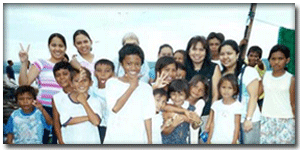
I was in my third year attending a leadership training seminar when the Miriam Volunteer Mission (MVM) program was first mentioned by Ms Malou Turalde, Coordinator of the program then. It rang in my ear. Then I followed it up at INSA the whole year through and even got to convince a partner.
Actually, it was not until April that Quennie Plopinio, a batch-mate, and I knew that we would indeed be sent for the volunteer mission. That meant the initiative or passion really came from me and my partner Quennie. While everyone was rushing to apply to this company and that, we were like the ‘called ones’ who responded or were given the grace to respond to a different kind of call.
Call to Freedom
What really motivated me was my desire to discern. I felt that my discernment would really be effective if I detached myself from things I was so fond of. In other words, retreat. I felt that being in a volunteer mission was perfect because there was no boyfriend to bug me every now and then. I would really be having quality time with myself, with other likeminded people, with God and with God’s people. I took the leap; so did Quennie.
The decision was solely mine. Ever since I heard about MVM and realized my interest in it, I had been telling my parents so they knew that I would not be earning money right after graduation for at least three months. Why did it seem so easy for them to approve of it or to let me be? I have never really been attached to my parents, I told them not to. I always asserted my independence, and having graduated from college seemed enough for them to let me do my thing after. So this free spirit soared and landed in Davao on 13 June 2004.
Mission Assignment
I found myself in the company of two 80-year-old Maryknoll Sisters. I stayed in the convent with them found inside a training center for youth with disabilities called ‘Our Lady of Victory’ (OLV). It is a very productive and alive community. People were gay and gleeful. It’s like a home in perfect harmony. Like heaven, perhaps!
While my partner was assigned to the OLV site in Samal, I remained in the OLV convent but worked in an NGO called ‘Philippine Agency for Community and Family’ or simply PACAF, directed by Sr Virgeen, one of the two Maryknoll Sisters around.
In PACAF, which is in mainland Davao, 20 minutes drive from the OLV convent, I was assigned as a community organizer (CO) tasked to serve three low-income areas, namely Purok 14 and 15 in Tibungco and Upper Malagamot in Panacan.
At Service
So, with Kuya Nars, an employed CO, we visited the three areas most days each week. What did we do? Well, I taught or facilitated the 4 to 6-year-old kids in the ‘Play Net’ once in a while. Mostly, we attended meetings of the homeowners’ association or the meetings of the Playnet kids’ parents.
Since one of my areas was newly penetrated by PACAF, I was tasked to conduct a survey to get a community profile. I did this for a week or two. Although it was a Muslim area, the people accommodated me warmly. Community leaders went around with me when I was doing the survey. The beauty of a volunteer is that it makes other people embrace you, and we need that warmth.
Many times, I just bummed around the areas talking to people, communing with them; making them feel they are important by simply paying attention to them. I learned from them how difficult life can get, as they were experienced at it. I learned it in a way that movies alone won’t let me. It was sharing, immersing in their kind of life.
But my best time at service was on 13 August when I became an instant big sister to seven children abandoned by their parents. I took care of them, bathed them and shared lunch with them. Then, I accompanied them to ‘House of Joy,’ an orphanage for youths where their needs for shelter, clothing and education are well met. I arrived at the convent when it was already 10:30 in the evening because the institution was in Davao del Norte, two hours away from my base. True, I was physically exhausted but I felt spiritually fulfilled and soul-nourishment matters most!
My gains as a volunteer
What did I learn as a volunteer? A lot! Actually I relearned them. I relearned how to live simply, how to serve God’s people, how to love God above all, how to appreciate life and family and those who love me. I relearned who I was and what I am meant for.
I did not encounter much difficulty when I was there. At work Kuya Nars and the other staff members always assisted or instructed me. There were times when I felt that I was not accomplishing much at work. I had difficulty trying to reconcile the irreconcilable reality and the ideal. But I learned soon enough.
I missed my family, yes, but I had quite a lifestyle there that made me enjoy life a bit too much because, luckily, we were ‘First-World volunteers’, as Ms Leah calls it, for things were easier for us. I had my own bedroom with its own lavatory. I ate cakes and cookies baked by Ate Alice, as much as I wanted to. I ate ice-cream almost every after meal. I got to play ping pong and chess, and swim at Samal. I had my OLV family. I gained Burmese friends. I was definitely not bored, rather always energized.
Reflections to Share
As a volunteer, I was simply struck by what I think is a fact that ‘Life is best lived simply.’ Being a volunteer with a very minimal allowance makes you a wise spender, and it’s true that God provides because I never ran out of money in my pocket or of food to eat.
When I had problems or difficulties, I talked to Ate Alice, the cook in the convent, or Ms Edna, Quennie’s supervisor there. I also sought advice from the other staff members of PACAF, who were so warm and friendly. Always, I prayed for God’s guidance and enlightenment.
Come on!
I invite young people to volunteer because it is high time that we give ourselves a break, to feel ease in God’s care, to listen to ourselves, to respond to God’s call to be His beloved children.
I encourage fellow students and graduates to volunteer because it is a very rich learning experience. It will open you to certain realities or problems that will make you part of the solution.
I want to persuade everyone to volunteer because it offers a different kind of fun wherein God takes care of the reward.
So if you feel any impulse at all, do not suppress, GO and experience life as a volunteer yourself! Let God lead you.
Shaine with friends
You may write to: Shayne Merioles #54 Emerald Court Bldg Road 3, Corner Road 8 Project 6 QUEZON CITY
Sitting At The Feet Of A Beggar
Sitting At The Feet Of A Beggar
By ‘Agnes’
The author, whose name and address are with the editor, works in a place that has known war. The experiences shared in the article are not unlike those of many in the Philippines.

For more than a year now, I have been among a new people, learning to be one of them in order to become part of their life and their history. As I study the language, I have also learned to study the people I daily meet on the streets as a way of learning to live my religious life in dialogue with their life. I feel there is much I can learn specially from the poor and suffering, those easily pushed aside into the margins of society.
A man named Joseph
He struck me the first time I went to the parish church where I daily attend the morning Eucharist. There was something fine and elegant in his features . . . the long, white beard that I only used to see in Chinese figurines . . . as he sat daily by the church gate to beg. I wondered what had led him to the life he leads now. Whenever I had small change in my purse, that was for him. For him too were part of my meals, which were often too much for me. Then one night, as I was walking home in a drizzle, I saw my beggar-friend rolled in a plastic bag sleeping on a sidewalk. So . . . he had no place to live, either. When I had to walk home at night in that direction and he was still awake, he would recognize me and wave his hand in greeting. One day I read that rather than just giving, the more meaningful gesture was to talk. So, with the little language I had I found out his name was ‘Joseph’ and introduced myself to him, too. I have moved away from that area since. I don’t know how long Joseph has been begging and how much longer he will continue, but I can guess he will do so until he dies.
Standing by the wayside
In a city crowded with thousands of motorcycles, the poorest of these drivers are the pedicab drivers. While the faster, stronger motorcycle overtakes them and pushes them to the outer lane, they continue to pedal their old dilapidated passenger-carriage in front of their bicycle. One day, there was the usual sign of an accident, a crowd gathered in the street. A motorcycle had collided with a pedicab, obstructing the traffic. As I watched the drama unfold before me, I thought of how this was so typical of what was happening in the rest of society. The young man driving the motorcycle was spitefully shouting at the pedicab driver, blaming him for the accident. The latter said nothing as, limping, he pulled his pedicab, which had fallen apart, to the sidewalk. All the people, including myself, simply watched until the street cleared, then moved on. How can a poor, uneducated man defend himself before the heavy-handed ways of the powerful and the knowledgeable? And we who continue to live simply as bystanders to the social drama?
No job too difficult
One day on my way to language school, I was aghast to see in the middle of the traffic a tall bamboo ladder with a man on top working on the electric wires running across the street. A man holding the ladder below was all the support there was in the swirl of motorcycles around it. I felt how vulnerable that man was . . . just the wrong swerve of a motorcycle . . .
How fragile life is and yet the poor have no choice. When you have no job, then even putting your life at stake by climbing a bamboo ladder in the middle of motorcycle traffic is acceptable . . . never mind the risks involved just so there may be food for the family today.
Every night at around 9 or 10 I hear it, a clear rhythmic ringing sound all along the street passing under my window and fading into the distance. I liked the sound and wondered what it was. It rose above the usual neighborhood noises of people talking, children playing, motorcycles running and was clearly meant to call people’s attention. Then one day I heard it, this time in the early afternoon. I looked around, following the sound and saw a boy perhaps 12 years old, rhythmically tapping a strip of metal against another wider band of metal in his hand while he walked briskly along the street. He didn’t seem to be just playing a game, attracting attention by the beautiful clear metallic ring he was making. Later, I asked around what this boy was about. He was one of those hired by mobile noodle vendors who announce by their metal ringing that they are ready to receive orders and to deliver them. How many hours a day do these young boys walk the streets? How much do they bring home to contribute to the family income? Do they miss playing as other boys their age are doing?
The lottery of life
The war had left four million people dead and three million wounded. You can imagine the number of physically handicapped people the long-drawn out war had produced. The government tries to help those who are not confined in institutions earn a livelihood by making them sell lottery tickets. You meet them all over the city, but I wasn’t ready for what I would encounter one day. I usually explore different ways to go around and one day I entered a side street. As I walked along, suddenly I saw a movement alongside the wall. It took me a moment to sort out that it was a man, but only ‘half a man’ Both his legs had been amputated at the thigh and he was rolling because he was lying on his brace and was trying to reach it to wrap it around his trunk. Beside him was his clipboard of lottery tickets to sell. I knew he needed help but I couldn’t bring myself to bend down and hold his brace for him . . . I turned around and hurriedly walked away from him. I was ashamed of myself when I became aware of what I was doing. I realized I was afraid at the way he looked.
Today, as I was finishing this article, we received a visit from a neighbor bringing a family in need of help: a handicapped beggar married to a woman with a family of five children to feed who had become insane. The 16-year-old daughter had also become insane. The lottery ticket distributor refused to give them any more tickets to sell, as they hadn’t been remitting payments.
And so the stories go on. There are many to tell so long as there are lives around us that speak from the depths of their deprivation and suffering.
My solidarity walk
What has the daily reading of the book of the life of the poor and those who suffer taught me for my religious life? First, is the humbling realization that I will never be able to live evangelical poverty as well as they do . . . what the harshness of life through long years has taught them . . . of the patience, the capacity to endure suffering in its many forms: humiliation, hunger, cold nights, hard work, danger . . . the vulnerability and defenselessness, the unabashed need for help of brothers and sisters, the radical, almost extreme trust in Providence, the capacity to marvel at grace, the spontaneous overflow of thanksgiving at the experience of goodness. They fill me with awe, these brothers and sisters, the ‘anawim’ , ‘the poor of God’, who powerfully bear God’s word for me. I admire what I see of the human spirit in them. I feel I must constantly sit at their feet to learn from them. And so I do, so I do.
The 'Dove' Of San Lazaro
This Columban lay missionary from Korea gives of herself to those on the fringes in Manila.
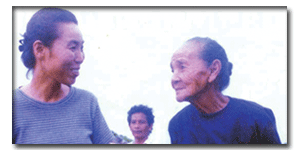 When Columban priests in Manila talk about Columban lay missionary Columba Chang, they’ll sometimes refer to her as ‘Saint Columba’, a bit of a tongue-in-cheek reference to the sixth century Irish saint who shares her baptismal name. Very few of them know that she’s actually named after Kim Hyo-im (Columba), one of the canonized Korean martyrs. (See ‘box’). Mostly, however, it’s a token of the genuine respect and admiration for the 49-year-old from Seoul, South Korea, and the exemplary life they have seen her live the past 16 years.
When Columban priests in Manila talk about Columban lay missionary Columba Chang, they’ll sometimes refer to her as ‘Saint Columba’, a bit of a tongue-in-cheek reference to the sixth century Irish saint who shares her baptismal name. Very few of them know that she’s actually named after Kim Hyo-im (Columba), one of the canonized Korean martyrs. (See ‘box’). Mostly, however, it’s a token of the genuine respect and admiration for the 49-year-old from Seoul, South Korea, and the exemplary life they have seen her live the past 16 years.
Columba was an accountant for a bank when she decided to become a lay missionary. At age 33, her parents joked that her motivation was to get away from getting married, but her real inspiration was a tremendous pull to help others. She had worked on weekends with Columban priests in her family’s parish in South Korea and answered the call when they suggested she would make a fine lay missionary.
‘My parents trusted the Columbans because we knew them in Korea,’ she said.
After taking language classes in Tagalog, Columba decided she wanted to work among the poorest of Manila’s poor: the squatters who live on and around the huge garbage dump in Quezon City, which includes some of Metro Manila’s sprawling, poverty-filled suburbs.
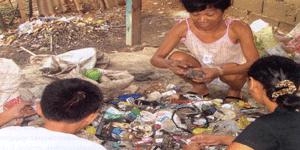
The infamous dump is called Payatas – known as ‘Smokey Mountain’. It is at this site of abject poverty where families gather up garbage and pick through the filth with their bare hands, picking out scraps of metal and plastic they can sell to recyclers to earn a few pesos.
Columba took me on a tour last June of the cobbled-together homes and marketplace near the dump site. The small shops, selling packaged foods and meats such as raw pork and sardines, emit a foul odor that mixes with the occasional whiff of feces and rotting garbage. I saw children playing with pebbles and cheap cardboard rather than toys. Families were busy sifting through and sorting trash, looking for anything they could take to the recycler.
In this dire setting, Columba said she immediately felt at home. She spent four years in a Payatas house, now since destroyed, doing various ministries with other religious groups in the area, including conducting home visits of children with mental deficiencies and other birth defects as part of a special education program for children operated by the Vincentian Missionaries.
Because of the environment children born in the grip of ‘Smokey Mountain’ have a high rate of birth defects, such as cerebral palsy, epilepsy, developmental delays, severe cleft palates and encephalitis (swelling of the brain). No studies have confirmed this, Columba says, but the high levels of iron and toxins and toxic fumes most certainly contribute to these defects.
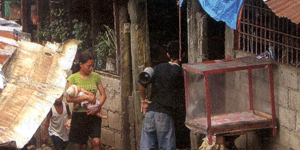
Tuberculosis is rampant here, with about 80 percent of residents suffering from the potentially deadly lung disease. Columba herself contracted TB during her first year there, but it did anything but discourage her.
‘When I got TB, I was happy in that I felt solidarity with the people’, she explained.
Columba said she also grew in her knowledge and understanding of God. As a Catholic in South Korea, she learned to view God as imposing and dominant, a type of male-centric worldview that’s common in Korean culture, she said. Through her work as a lay missionary, she began to see a God who came to Earth in the form of Jesus Christ – ‘vulnerable, helpless, generous and friendly’, in her words. ‘He is there in the midst of the suffering of the people’.
Columba told me she now feels free to be herself, an expression of her personal growth she didn’t experience until she became a lay missionary, which she says has been her true calling from God.
HIV-AIDS Counseling
(Names here have been changed)
After life at Payatas and a year’s sabbatical in England and Wales in 2002-03, Columba returned to Manila, this time to work with Caritas Manila, an arm of the Archdiocese, where she is the HIV-AIDS Progam Coordinator. She counsels persons with HIV-AIDS patients in San Lazaro Hospital and their families. She also brings her ministry to HIV-AIDS patients held in 13 city jails in Metro Manila.
She said she knew little about HIV-AIDS at first, but began to hear stories from Sisters about the stigma that many in Asian cultures face when they contract the disease, which is usually sexually transmitted. Many are prejudged, Columba said, as sex addicts or sex workers, and there are misconceptions about how the disease is contracted.
Officially, the Philippines’ government reports just 2,800 cases of HIV-AIDS in the nation, which, Columba says, is commonly understood to be grossly understated. But as a result of this report, she said, the Catholic Church has put few resources into helping HIV-AIDS sufferers, saying the low numbers of patients means resources can be better directed elsewhere. Columba said she trained herself to learn about HIV-AIDS by gathering information through government agencies.
Columba counsels young men like Clark and Renan, two young men I met who had arrived at the hospital in June for treatment. Both men found out they had the treatable but incurable disease after taking blood tests so they could apply to work overseas. Columba provides them and others with a helpful ear, listening to their stories and worries and providing them with the spiritual and emotional support they are looking for.
‘Patients ask questions like “Where is God? Why me?” I just try to help’, Columba says.
Clark and Renan looked healthy and were scheduled to be released from the hospital to resume their lives and were able to get jobs overseas. Others at the hospital were in more despairing straits.
Gina, with a copy of The Purpose Driven Life at her side, was at the hospital the day I visited, suffering with red rashes caused by the anti-retroviral (ARV) drugs used to treat her.
Armando, a young man from Mindanao, was gaunt and bed-ridden, with a nurse washing his now rail-thin legs dotted with sores. He had denied he was sick for a long time, Columba said, agreeing to a hospital visit only after he had contracted pneumonia. Sadly he has died since.
A New Mission
Columba has applied to become the first Columban lay missionary in Myanmar (Burma), where Columban priests and Sisters were a significant missionary presence in the pre-Second Vatican Council days. Columbans are working to re-establish their presence in this Southeast Asia nation.
Columba said she will soon learn if she is accepted and wants to live in Myanmar because she is ‘looking for more of a challenging place’ and because she wants to teach what she has learned about her Catholic faith and about AIDS, which is a growing problem in Myanmar.
There is no question, Columba said, that she is called to be a lay missionary.
‘This is the way I’d like to live for the rest of my life, to serve the poor’.
Robert Fraass has been the editor of Columban Mission since 2001. He visited Columban missionaries in the Philippines in June 2007. You may email Columba at eunyeal@yahoo.com
ST COLUMBA
‘Columba’ is the Latin for ‘dove’ and is part of the name of a number of Irish saints, the most notable being St Columba or Colm Cille (‘The dove of the chapel’) and St Columban(us), the patron of Columban missionaries. Both of these monks were Irish and contemporaries. Columba’s dates are 521 – 597 while those of Columban are c540 – 615.
The subject of the article, Chang Eun-Yeal, whose Christian name is added, according to the custom of Korean Catholics, is named after Kim Hyo-im (Columba) who with her sister Agnes, was martyred in 1839. The Korean Columba, a woman, was named after the Irish saint, a man.
In his homily in Seoul on 6 May 1984 at the canonization of 103 Korean Martyrs, including Columba and Agnes, Pope John Paul II said, ‘Yearning for an ever greater share in the Christian faith, your ancestors sent one of their own in 1784 to Peking (Beijing), where he was baptized. From this good seed was born the first Christian community in Korea, a community unique in the history of the Church by reason of the fact that it was founded entirely by lay people. This fledgling Church, so young and yet so strong in faith, withstood wave after wave of fierce persecution. Thus, in less than a century, it could already boast of some ten thousand martyrs. The years 1791, 1801, 1827, 1839, 1846 and 1866 are forever signed with the holy blood of your Martyrs and engraved in your hearts’.
The 103 official saints are a ‘sample’ of those of all backgrounds and ages who died in the various persecutions. 20 September is their feast day.
RELATED WEBSITES
You can find Columban Mission at www.columban.org the website of the Columbans in the USA, by clicking on ‘Columban Mission magazine’ on the left.
Caritas Manila is at www.caritasmanila.org.ph
You can find some videos of Vincentian projects in Payatas atwww.famvin.org/wiki/Vincentians_and_YouTube . Scroll down to ‘Vincentians – Philippines’.
There is a restricted online photo gallery by Bobby Wong who works with the Vincentians in Payatas at www.pbase.com/bobbyw/payatas_dump . Bobby has another gallery atwww.pbase.com/bobbyw/mycharities .
www.cmphilippines.org.ph is the website of the Philippine Provinces of the Vincentians, whose official name is ‘Congregation of the Mission’.
They Too Mourned For Him

Fr Jesus Reynaldo A. Roda OMI, ‘Father Rey’, expected it all along. But not the people of Tabawan, whom he had served for ten years before his brutal murder on 15 January at the hands of his abductors. One of Father Rey’s Muslim scholars described the immediate reaction of the local people: ‘It was as if a big bomb was dropped in our midst and we got the shock of our lives. The whole island mourned. Some lost their appetite. Some kids don’t want to go to school anymore’.
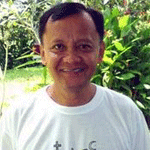
Desecration of Sacred Grounds
Tabawan is one of the beautiful islands of Tawi-Tawi, the southernmost province of the Philippine archipelago. It is inhabited by peace-loving Samals and prides itself on being a peaceful and tolerant society. That is why the brutal murder of a missionary priest in this island is hard for the local inhabitants to accept. Ultimately, they saw it as a desecration of their sacred ground.
The Oblates of Mary Immaculate, a missionary congregation, started to establish mission stations in the Muslim-dominated provinces of Cotabato, Sulu, and Tawi-Tawi in 1939. Since then, they have been living with Muslims while serving the minority Christian population of the islands.
After World War II, the Oblates put up Notre Dame Schools in the islands to respond to the increasing demand for education in the region. These were welcomed by the local Muslims. Not only that. Over the years, the local people also started to develop strong affection for the missionaries. This was especially true in the case of Fr Leopold Gregoire OMI, a Canadian.
Fr Gregoire was the director of Notre Dame School in Tabawan for 20 years until his death. He died many years ago but until now, not only the Notre Dame community celebrates his birthday every year but the entire island. The celebration is called ‘Father Gregoire Day’ and goes on for three days with a lot of fanfare. The town has a population of more or less 20,000, with only thirty Christians.
For Love of Others
It was around 7:30 in the evening. Father Rey was praying inside the chapel, as he used to do after supper, when he was taken forcibly by his captors. When he refused to go with them, they shot him dead. The Oblates in the Vicariate have agreed among themselves not to go with the attackers in the event of a kidnapping attempt. The reason is that in many kidnapping incidents in Mindanao, the subsequent military operations usually take their toll not only among the combatants but also among the civilians. Father Rey chose to sacrifice his life in order to prevent the loss of more lives.
There were some students at the campus at the time of the killing. They were taking a computer class. The class is held in the evening because it’s the only time that the school generator is running. There is no electricity on the island. When the armed men left, they took Mr Taup, a Muslim teacher, with them.
Losing one of their own
Ordained on 10 May 1980, Father Rey had deep compassion for the poor. He was in the forefront of justice and peace work in the Diocese of Kidapawan during the Martial Law days. Prior to his assignment in Tabawan, he was a missionary in Thailand where he interacted with Buddhist society. In Tabawan, he not only directed the school and supported many scholars but also implemented several socio-economic projects for the poor in close coordination with a number of NGOs and government agencies. In 2003, he was actively involved during the surge of deportees from Sabah, Malaysia, providing them with food and shelter.
The death of Father Rey brought back to my memory that fateful day, 4 February 1997, when Bishop Benjamin de Jesus OMI was murdered in front of Mt Carmel Cathedral in Jolo. This was followed nearly four years later by another tragedy when Fr Benjamin Inocencio OMI was murdered at the back of the same cathedral on 28 December 2000.
Just like what happened after the deaths of Bishop Ben and Father Benjie, the Muslims mourned. They also mourned Father Rey’s death, especially the people of Tabawan whom he had learned to love. They literally had lost one of themselves.
One in Sorrow
I saw Samud being interviewed by Ces Drilon on ABS-CBN TV. He is the same convento boy, a Muslim, whom I met when I was based in Bongao from 1990 to 1994. The day after the killing, Fr Raul M. Biasbas OMI, a classmate of Father Rey on another island in Tawi-Tawi, called Samud by cellphone to ask what had really happened. ‘I’m very sorry, Father, I was not able to protect Father Rey,’ he answered in tears.
I spoke to Wija, one of Father Rey’s scholars, also a Muslim. She called him ‘Tatay’, ‘Dad’. During the commotion at the convento with the armed men, she rushed to help him but he shouted at her, ‘Anak, tumakbo ka na!’, ‘Run, daughter!’ She accompanied the body of Father Rey from Tabawan to Cotabato on board a military helicopter provided by the Philippine Air Force. She brought with her an album containing pictures of Father Rey and herself, which she keeps with fondness.
In Bongao island where Father Rey was waked for two days, Muslims and Christians filled Holy Rosary Church. The Muslims even brought food during the wake. In Cotabato City, Muslims and Christians were crying along the highway as Father Rey’s remains were transported from Awang Airport to a funeral parlor in the city. Many Muslims also came during the wake and attended the burial at the Oblate cemetery in Tamontaka.
This was very consoling. While we grieved for the death of Father Rey, we found solace not only in the support of fellow Christians but also in the support given by Muslims, including the Moro Islamic Liberation Front and several NGOs, through their personal condolences and public condemnations of the murder.
Boundaries Transcended
To me, this outpouring of support reveals that human goodness transcends even religious boundaries. Indeed, it is possible for Muslims and Christians to work together to create a peaceful society if only we learn to shed our human biases and focus on doing God’s will for his people.
We do not exactly know what Father Rey was telling God when he was praying inside the chapel. Perhaps, he was telling Him about his many dreams for the people of Tabawan. Now that he is gone, only the memory of Father Rey remains in the hearts of the Muslim and Christian inhabitants of this island.

Father Rey would have turned 54 on 5 February.
You may email the author at bertlayson2002@yahoo.com
or write him at Immaculate Conception Parish, PIKIT, 9409 Cotabato
Unrevealed Domestic Violence
By: Maurice L. Galasa CICM
The author is a seminarian in vows of the CICM Congregation and is working at present in Zambia. He is from Bontoc, Mountain Province.
 God had sent me here to Zambia and it was indeed a wonderful experience to integrate myself with the people. I listened to their noble stories of how God is actively present in their struggles of pain. It was in listening to these that I was ‘converted’ to God and became part of their journey. An encounter with Mrs Anne Banda in one of my house visits in Bouleni, Lusaka, helped me appreciate God’s calling me to be a missionary.
God had sent me here to Zambia and it was indeed a wonderful experience to integrate myself with the people. I listened to their noble stories of how God is actively present in their struggles of pain. It was in listening to these that I was ‘converted’ to God and became part of their journey. An encounter with Mrs Anne Banda in one of my house visits in Bouleni, Lusaka, helped me appreciate God’s calling me to be a missionary.
She recalled that when her daughter Shammah was admitted to Bouleni Clinic in December 2006 with severe nose-bleeding, she didn’t know that the doctors would diagnose a totally different ailment that would change her life totally and later lead her to the graveyard. Mrs Banda had rushed her 18-year-old daughter from Kawata Village to a nearby witchdoctor to have the excessive bleeding, swollen head and other complications healed. But his rituals achieved nothing. So she was forced to take Shammah to the clinic despite their lack of money.
The doctor managed to stop the bleeding but the other complications became so bad that during the subsequent six months of attending the clinic there was no improvement. After further examination, her doctor suggested that an HIV test be done. Her mother, after hesitating for some days, consulted Shammah’s husband. But he became arrogant and didn’t want to hear anything of that nature. He accused the parents of his wife of fabricating stories that he had made their daughter sick. As far as he was concerned, he was done with Shammah. After all, he had moved on and was now living with another woman.
After getting Shammah’s belongings from her husband, Mrs Banda went to consult her brother who suggested that the test be done to determine if indeed it was HIV that was the matter with her. Shammah herself couldn’t make a decision due to the degree of her sickness. The results showed not only that Shammah was HIV-positive, but that her heart valves weren’t functioning properly. The doctor told them that her mitral (bicuspid or left atrioventricular) valve wasn’t allowing oxygenated blood to move freely from the left atrium into the left ventricle. This is a form of rheumatic heart disease
Mrs Banda related, ‘When they told me about the results, I was very shocked. My mind was full of thoughts of where we were going to get the life-prolonging drugs, ARVs. We didn’t have the money. This was a double tragedy for me and my family. What would happen to her two children? The three-month-old baby needed lactogen, as Shammah was too ill to breastfeed. I wish we never knew the problem my daughter had. It makes me feel bad’, said Mrs Banda with sobs and tears.
Shammah was in and out of the clinic for six months while relatives tried to arrange money for her to buy the ARVs. Herbs couldn’t heal her. She lost so much weight . The doctors, seeing that she wasn’t improving, transferred her to a hospice where she died two weeks later, on 18 June 2007.
Mrs Banda lamented, ‘It’s so sad to see that my daughter’s light, slim body and pretty face that had swept many men off their feet, was no longer functioning’. Shammah’s husband never showed up at the funeral. Her family and cousins tried to locate him only to discover he had moved into the house of the woman he had married when Shammah was already sick.
At this point, the family and relatives came to know the truth from Kenan, Shammah’s two-year-old son, about the abuses of his father. He said that Shammah had been a ‘punching-bag’. She was beaten each time she asked her husband why he was going out with other women when he had her. When she kept quiet the situation was worse. He would say, ‘You don’t care about me. Why aren’t you asking where I slept so I can kill you too?’ Her husband would also force her to cultivate their field or she wouldn’t eat. Shammah couldn’t report her husband to the police or her family. She kept quiet because she had been forewarned that the man she was marrying was bad, despite his good outward appearance. Besides that warning, she didn’t report the domestic violence because she thought that what was important was to maintain her marriage at all costs.
After Shammah’s burial, when relatives were searching in one of her handbags, they found some STI medication, which suggested she had suffered sexually transmitted infections, possibly from her husband. Although Shammah said at one time that she had seen some signs of plunging herself into danger, she never thought she would die of an HIV/AIDs-related illness.
The hardest and most shocking part came five months after Shammah was laid to rest at the Leopard Hill Cemetery, when her husband resurfaced, wanting to have Kenan.
Kenan was now a big boy. Thank God, when he was taken for an HIV test, it proved negative. Shammah’s husband appeared and claimed the child. After hesitation, Shammah’s family forgave him after he paid an admission-of-guilt fee of ZMK200,000 (Zambian kwacha), the equivalent of US$500 or more than Php20,000. [Editor’s note: the Gross National Income (GNI) of Zambia in 2002 was $330 per capita, that of the USA $35,060 and that of the Philippines $1,020. Source: The World Guide, New Internationalist Publications Ltd, 2005.] He was forgiven and given custody of the child. The other reason that caused them to let go of Kenan was that they didn’t have enough money to send him to school as he grew up.
Six months later Kenan died of a high fever.
When Mrs Banda went to the funeral she was amazed at the story of the mistreatment the young boy went through, how he was a victim of beatings by his father for failing to tell him where his stepmother had gone at times. He was oftentimes sent to buy beer for his father, despite heavy rain that caused his illness and eventually his death. The burial of Kenan marked the end of the unspoken domestic violence.
Shammah and Kenan now rest in silence with God. They are gone but their message of justice and peace are not forgotten.
You may write the author at: CICM MISSIONARIES Kabwe, PO Box 81033, 844 Great North Road, Dallas, KABWE, ZAMBIA or email him at mauricegalasa@yahoo.com